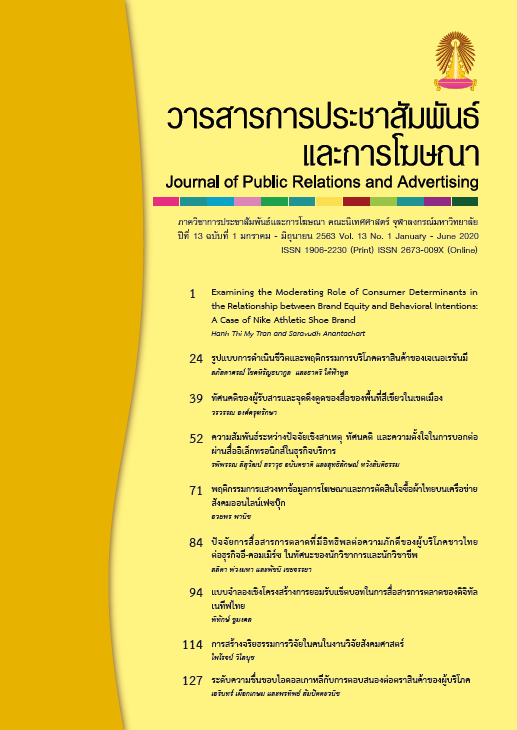Korean Idol Preference Scales and Consumers’ Response towards Brands
Main Article Content
Abstract
Nowadays, the society is in a state of intense marketing competition. Consumer response regarded as an important matter for the brands. The biggest problem for all marketing strategists is how do products imported into the market will receive good response from consumers. One of the strategies that has been used a lot in the present day is to use Korean idols as the representative for the brand in order to stimulate consumer response. This research aims to study the level of Preference towards Korean idols (Korean Idol Preference Scales), Information Exposure behavior towards Brand using Korean idol as representative. And influences that affect the responses of consumers to Korean fan groups in terms of Cognitive, Affective and Behavior using quantitative research methods by collecting online questionnaires from 400 samples.
The results showed that the sample group, which is Korean idol fans, has a moderate level of Korean Idol Preference Scales. The sample group has behaviors that are exposed to the information of brand that has Korean idols as the presenter at the moderate level. And has responded to the brand that has Korean idol as a presenter at a high level. Moreover, the results found relationship between Korean Idol Preference Scales and Information Exposure behavior towards Brand using Korean idol as representative. The results also found the influence of Korean Idol Preference Scales and Information Exposure behavior towards Brand using Korean idol as representative that affect the consumer response in terms of Cognitive, Affective and Behavior. It found that Korean Idol Preference Scales effects to consumer response the most in every terms.
Article Details
References
ตุล อัคนิบุตร. (2556). อิทธิพลของการโฆษณาที่ใช้พรีเซนเตอร์นักร้องเกาหลีต่อทัศนคติและความตั้งใจซื้อของวัยรุ่นหญิงในกรุงเทพมหานคร. (วิทยานิพนธ์ปริญญามหาบัณฑิต). มหาวิทยาลัยเกษตรศาสตร์, คณะนิเทศศาสตร์และสารสนเทศ.
ปรมะ สตะเวทิน. (2540). หลักนิเทศศาสตร์. พิมพ์ครั้งที่ 9. กรุงเทพฯ: ภาพพิมพ์.
ปรมะ สตะเวทิน. (2541). การสื่อสารสารมวลชน: กระบวนการและทฤษฎี. (พิมพ์ครั้งที่ 2.) กรุงเทพฯ: ภาพพิมพ์.
ภัสสรนันท์ เอนกธรรมกุล. (2553). ผลกระทบจากการใช้บุคคลที่มีชื่อเสียง (Celebrity) ที่เป็นผู้นำเสนอสินค้าหลากหลายตราสินค้าในงานโฆษณา. (วิทยานิพนธ์ปริญญามหาบัณฑิต). มหาวิทยาลัยธรรมศาสตร์, คณะพาณิชยศาสตร์และการบัญชี.
รัตนาภรณ์ เทพเกษตรกุล. (2555). การตอบสนองของผู้บริโภคที่มีต่อการใช้พรีเซ็นเตอร์เกาหลีโฆษณาสินค้าในประเทศไทย. (การค้นคว้าอิสระปริญญามหาบัณฑิต). มหาวิทยาลัยธรรมศาสตร์, คณะพาณิชยศาสตร์และการบัญชี.
อุบลศรี ร่มโพธิ์คาพงษ์. (2554). ทัศนคติและการตัดสินใจซื้อสินค้าความเกี่ยวพันสูงและต่ำที่มีศิลปินเกาหลีเป็นผู้นำเสนอ. (วิทยานิพนธ์ปริญญามหาบัณฑิต). จุฬาลงกรณ์มหาวิทยาลัย, คณะนิเทศศาสตร์.
ภาษาอังกฤษ
Beck, A. T., Freeman, E., & Associates (1990). Cognitive Therapy of Personality Disorders. London: The Guilford Press.
Burcher, Nick. (2012). Paid, owned, earned: maximizing marketing returns in a Socially Connected World. London. Kogan Page Ltd.
Fiske, John. (1992). The Cultural Economy of Fandom. New York: Routledge.
McCutcheon, L. E., Lange, R. and Houran, J. (2002), Conceptualization and measurement of celebrity worship. British Journal of Psychology. 93(1), 67-87.


